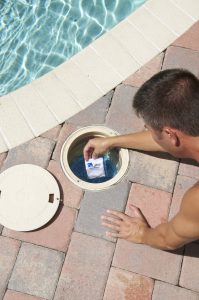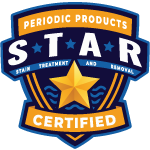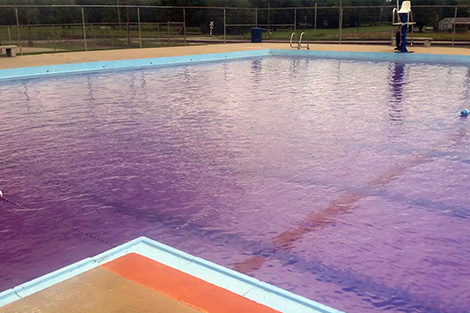Help! My Pool Water Turned Purple!
Help! My pool water turned purple! Chances are you landed on this page because you have scary purple pool water. Purple swimming pool water can be easily treated using our directions, one of our kits, and a little bit of time.
Click on one of the purple pool images below to learn how to get rid of your purple pool problems.
What is the cause of purple swimming pool water?
In almost all cases, purple pool water is caused by copper cyanurate in your pool water.
Cyanuric acid, also known as stabilizer, conditioner, or CYA, is present in two common forms of chlorine: Dichlor (Sodium Dichloro-S-Triazinetrione) and Trichlor (Trichloro-S-Triazinetrione). Cyanuric acid can also be added separately to pool water to stabilize chlorine from sunlight. Cyanuric acid accumulates in pool water and in the presence of high copper metal levels, forms purple-colored copper cyanurate. This compound often stains pool surfaces purple over time. Removing both copper and cyanuric acid from the pool water will result in clear, colorless water.
Where does the copper in my pool come from?
To maintain the water quality and aesthetics of your pool, it’s essential to identify the various sources of copper entering the water. These sources include algaecides and well water, which often contains high levels of copper and other stain-causing metals when used to fill or top off the pool.
Additionally, high copper content in the source water can result in purple or blue water and staining. Damaged or corroded pool equipment, copper heaters, metal pipes, and fittings can introduce copper and other metals, causing discoloration.
Rain or irrigation water coming into contact with stones, statues, copper spouts, water features, or fertilizers can lead to copper accumulation and purple water. Moreover, ionizer systems and chlorine tabs contribute to copper build-up over time. By identifying and addressing these sources, you can effectively prevent copper-related issues and enjoy crystal-clear pool water.
How do I remove copper from my swimming pool?


CuLator Metal Eliminator and Stain Preventer!
The only way to remove and eliminate stain-causing metals like rust, iron, copper, manganese, and cobalt without draining your swimming pool water is CuLator.
CuLator removes and captures metals inside the CuLator bag for easy removal. It works in a wide range of pH and doesn’t dissolve in water, so it doesn’t add to your TDS. CuLator finishes what sequestering agents and metal control products start.
There are two sizes of CuLator:
The CuLator PowerPak 1.0 removes 1 ppm dissolved metals from 20,000 gallons and is placed into the skimmer basket. The CuLator Ultra 4.0 removes 4 ppm dissolved metals from 20,000 gallons of pool water. The Ultra 4.0 also includes a GatorEgg protective cage which allows the Ultra to be placed into the pump basket. When the CuLator removes metals from pool water, the contents usually change color to identify those metals removed! CuLator removes and eliminates these stain-causing metals from pool wa
CuLator Metal Eliminator & Stain Preventer Before Use


CuLator Metal Eliminator & Stain Preventer After Use


Where does the cyanuric acid (CYA) in my pool come from?
Cyanuric acid, also known as stabilizer or conditioner, is commonly used in swimming pools to protect chlorine from degradation caused by sunlight. It helps maintain chlorine’s effectiveness, reducing the need for frequent chlorine replenishment.
CYA or Cyanuric acid is typically added intentionally to pool water, and there are a few ways it can be introduced: Adding Stabilizer Directly-pool owners and operators can add cyanuric acid directly to the pool water as a powdered or granular form. This is a controlled method of introducing stabilizer and allows for accurate dosage based on the pool size and water volume.
Stabilizer-Containing Chlorine Products-some chlorine products, especially stabilized chlorines like trichlor and dichlor, contain cyanuric acid as an ingredient. When these chlorine products are used, they release both chlorine and cyanuric acid into the water. Pre-Filled Products-some pool care products, such as chlorine tablets or pucks, can come pre-packaged with cyanuric acid. When these products dissolve in the water, they release both chlorine and stabilizer.
Splash-In or Rainwater-if pool water is splashed out of the pool or if rainwater enters the pool, it can potentially introduce small amounts of cyanuric acid if the surrounding environment contains the compound. This is usually a minor source compared to intentional additions.
It’s important to note that while cyanuric acid provides important benefits in maintaining chlorine levels, excessive levels of cyanuric acid can lead to problems. High levels can reduce chlorine’s effectiveness, leading to issues with water sanitation. Regular testing of pool water, along with proper dosing and monitoring of cyanuric acid levels, is essential for maintaining a safe and properly balanced pool environment.
How do I remove CYA (Cyanuric acid) from my swimming pool?
The most effective way to remove CYA (Cyanuric acid) from your swimming pool is to drain a safe amount of the pool water and refill with fresh water. Check with a pool professional to determine what amount is safe to remove from your specific pool. Drain some and refill until the CYA level is between 30-50 ppm.
There are CYA removers on the market, but they are expensive and not very effective.



